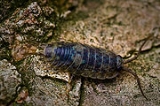
Ligia oceanica
Encyclopedia
Ligia oceanica, the sea slater, common sea slater or sea roach, is a littoral woodlouse
.
L. oceanica is oval, twice as long as broad and may reach up to 30 millimetres (1.2 in) in length, making it the largest oniscid
isopod. Its colour may vary from grey
to olive-green, and it has large compound eyes and long antennae
, ⅔ as long as its body.
L. oceanica is found in temperate waters
from Norway
to the Mediterranean Sea
, and from Cape Cod
north to Maine
. It is a common species, occurring wherever the substrate of the littoral zone
is rocky, and is especially common in crevices and rock pools and under stones. It is a nocturnal
omnivore
, eating many kinds of seaweed
,
diatoms and debris
, with a particular fondness for bladder wrack
(Fucus vesiculosus).
L. oceanica individuals live for 2½–3 years and usually breed only once.
Woodlouse
A woodlouse is a crustacean with a rigid, segmented, long exoskeleton and fourteen jointed limbs...
.
L. oceanica is oval, twice as long as broad and may reach up to 30 millimetres (1.2 in) in length, making it the largest oniscid
Woodlouse
A woodlouse is a crustacean with a rigid, segmented, long exoskeleton and fourteen jointed limbs...
isopod. Its colour may vary from grey
Grey
Grey or gray is an achromatic or neutral color.Complementary colors are defined to mix to grey, either additively or subtractively, and many color models place complements opposite each other in a color wheel. To produce grey in RGB displays, the R, G, and B primary light sources are combined in...
to olive-green, and it has large compound eyes and long antennae
Antenna (biology)
Antennae in biology have historically been paired appendages used for sensing in arthropods. More recently, the term has also been applied to cilium structures present in most cell types of eukaryotes....
, ⅔ as long as its body.
L. oceanica is found in temperate waters
Temperate
In geography, temperate or tepid latitudes of the globe lie between the tropics and the polar circles. The changes in these regions between summer and winter are generally relatively moderate, rather than extreme hot or cold...
from Norway
Norway
Norway , officially the Kingdom of Norway, is a Nordic unitary constitutional monarchy whose territory comprises the western portion of the Scandinavian Peninsula, Jan Mayen, and the Arctic archipelago of Svalbard and Bouvet Island. Norway has a total area of and a population of about 4.9 million...
to the Mediterranean Sea
Mediterranean Sea
The Mediterranean Sea is a sea connected to the Atlantic Ocean surrounded by the Mediterranean region and almost completely enclosed by land: on the north by Anatolia and Europe, on the south by North Africa, and on the east by the Levant...
, and from Cape Cod
Cape Cod
Cape Cod, often referred to locally as simply the Cape, is a cape in the easternmost portion of the state of Massachusetts, in the Northeastern United States...
north to Maine
Maine
Maine is a state in the New England region of the northeastern United States, bordered by the Atlantic Ocean to the east and south, New Hampshire to the west, and the Canadian provinces of Quebec to the northwest and New Brunswick to the northeast. Maine is both the northernmost and easternmost...
. It is a common species, occurring wherever the substrate of the littoral zone
Littoral
The littoral zone is that part of a sea, lake or river that is close to the shore. In coastal environments the littoral zone extends from the high water mark, which is rarely inundated, to shoreline areas that are permanently submerged. It always includes this intertidal zone and is often used to...
is rocky, and is especially common in crevices and rock pools and under stones. It is a nocturnal
Nocturnal animal
Nocturnality is an animal behavior characterized by activity during the night and sleeping during the day. The common adjective is "nocturnal"....
omnivore
Omnivore
Omnivores are species that eat both plants and animals as their primary food source...
, eating many kinds of seaweed
Seaweed
Seaweed is a loose, colloquial term encompassing macroscopic, multicellular, benthic marine algae. The term includes some members of the red, brown and green algae...
,
diatoms and debris
Debris
Debris is rubble, wreckage, ruins, litter and discarded garbage/refuse/trash, scattered remains of something destroyed, or, in geology, large rock fragments left by a melting glacier etc. The singular form of debris is debris...
, with a particular fondness for bladder wrack
Bladder wrack
Fucus vesiculosus, known by the common name bladder wrack or bladderwrack, is a seaweed found on the coasts of the North Sea, the western Baltic Sea, and the Atlantic and Pacific Oceans, also known by the common names black tang, rockweed, bladder fucus, sea oak, black tany, cut weed, dyers fucus,...
(Fucus vesiculosus).
L. oceanica individuals live for 2½–3 years and usually breed only once.

